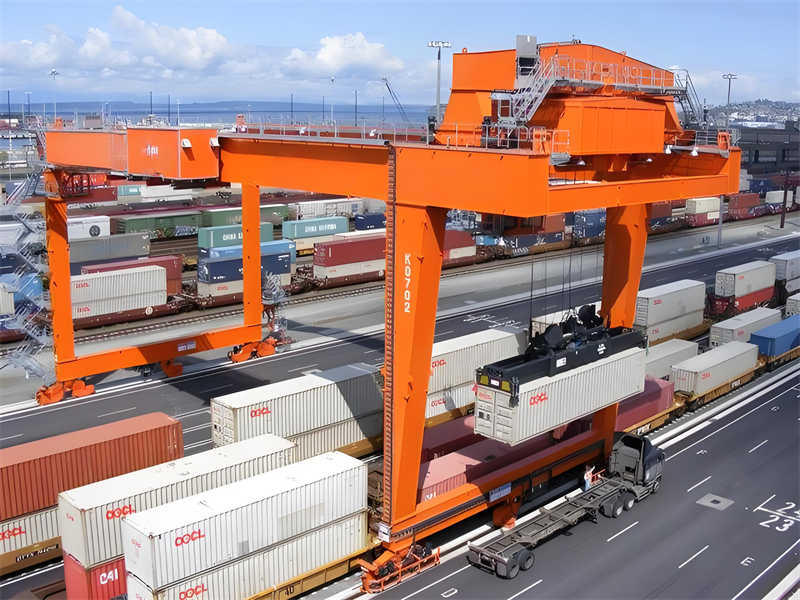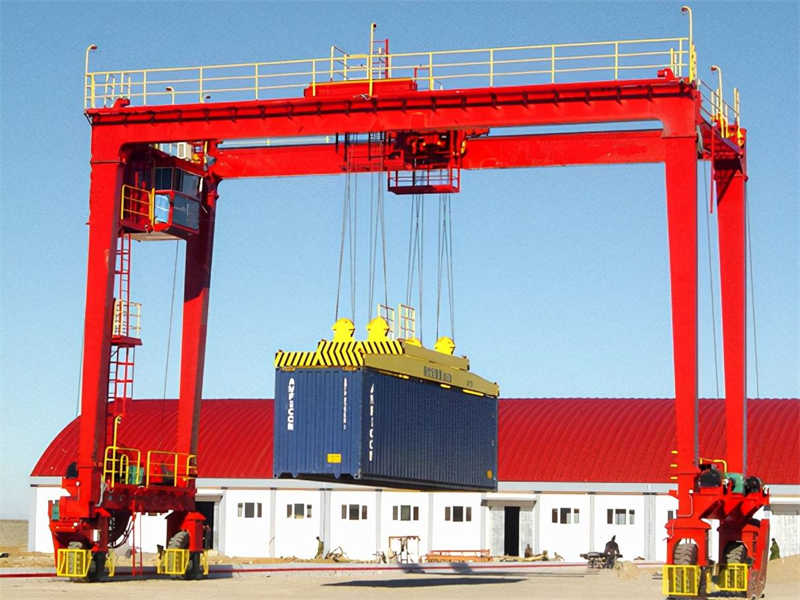Container Crane Buying Guide: RMG vs. RTG – Which is Right for Your Operation?
– Expert Advice from Dongqi Crane, Your Trusted Crane Manufacturer
1. Introduction
Choosing the right container handling equipment is critical for port terminals, intermodal yards, and logistics centers. As a leading global crane manufacturer, Dongqi Crane provides this comprehensive comparison between Rail-Mounted Gantry Cranes (RMG) and Rubber-Tyred Gantry Cranes (RTG) to help you make an informed decision based on your operational needs.
2. What is a Rail-Mounted Gantry Crane (RMG)?
Technical Definition and Core Components

A Rail-Mounted Gantry Crane (RMG) is a specialized container handling system that operates on fixed parallel rail tracks, typically spanning the width of multiple container stacks in a terminal yard. The fundamental architecture consists of several critical subsystems:
- Structural Framework:
- Twin vertical legs connected by an overhead bridge girder
- High-strength steel construction (typically ASTM A572 Grade 50 or equivalent)
- Box-type girder design for optimal strength-to-weight ratio
- Motion Systems:
- Rail running gear with heavy-duty wheels (often 8-12 wheels per leg)
- AC frequency-controlled drive motors (typically 30-100 kW depending on span)
- Anti-derailment safety devices and rail end buffers
- Lifting Mechanism:
- Wire rope hoist system with 4/8 rope reeving
- Spreader beam with twistlock mechanisms
- Load sensing and overload protection systems
Operational Characteristics
RMGs demonstrate distinct performance attributes that make them particularly suitable for certain operational environments:
- Precision Handling:
- Positioning accuracy within ±5mm
- Minimal load swing due to fixed rail guidance
- Capable of single-pass container stacking up to 6-high
- Throughput Capacity:
- Typical cycle times of 90-120 seconds per move
- Sustained operation at 25-35 moves per hour
- Capable of 24/7 operation in automated configurations
- Environmental Performance:
- Electric power consumption averaging 15-25 kWh per move
- Regenerative braking energy recovery systems
- Noise levels below 75 dB at 10m distance
Comparative Advantages in Terminal Operations
Infrastructure Synergies:
- Direct integration with automated stacking crane (ASC) systems
- Compatibility with automated guided vehicle (AGV) transfer points
- Seamless interface with terminal operating systems (TOS)
Maintenance Profile:
- Mean Time Between Failures (MTBF): 1,500-2,000 hours
- Scheduled maintenance intervals: 500-750 operating hours
- Typical service life: 25-30 years with proper maintenance
Safety Features:
- Redundant braking systems (mechanical + regenerative)
- Anti-collision systems using laser/LIDAR technology
- Emergency stop systems with <0.5 second response time
Limitations and Operational Constraints
Spatial Requirements:
- Minimum 50m straight rail section for proper operation
- Foundation requirements: 200-300 kN/m² bearing capacity
- Clearance needs: 1m lateral clearance, 2m vertical clearance
Meteorological Considerations:
- Standard operating wind speed limit: 20 m/s
- Survival wind speed: 36 m/s (when parked)
- Temperature range: -30°C to +50°C (with special configurations)
3. What is a Rubber-Tyred Gantry Crane (RTG)?

Technical Definition and Core Configuration
A Rubber-Tyred Gantry Crane (RTG) is a mobile container handling system characterized by its elevated gantry structure mounted on rubber-tired bogies for ground mobility. The fundamental architecture consists of:
- A rigid portal frame spanning 18-35 meters
- 4-8 heavy-duty pneumatic or solid rubber tires
- Diesel-electric or fully electric power systems
- Hydraulic or electromechanical steering mechanisms
- Container spreader with twistlock system
Mobility and Operational Flexibility
RTGs offer unparalleled mobility in terminal operations:
- Steering Configurations:
- 90° cross-terminal movement
- 45° diagonal travel capability
- Crab steering for precise positioning
- Turning Radius: Typically 25-35 meters depending on span
- Gradeability: Can operate on 1-2% slopes without performance degradation
- Surface Requirements: Paved asphalt or concrete with proper load-bearing capacity
Power Systems and Energy Management
Modern RTGs feature advanced power options:
- Diesel-Electric Hybrid Systems:
- 150-300kW diesel generators
- Battery energy storage systems (20-100kWh)
- Typical fuel consumption: 15-25 liters/hour
- Full Electric RTGs:
- 400-600V external power connection
- Cable reel or conductor bar systems
- Onboard supercapacitors for peak power demands
- Alternative Energy Options:
- Hydrogen fuel cell hybrids
- Lithium-ion battery storage
- Solar-assisted power systems
Load Handling Characteristics
- Capacity Ranges: 30-50 metric tons under spreader
- Lifting Heights: Up to 18 meters (6 high container stacking)
- Hoisting Speeds: 15-30 m/min (full load) / 30-50 m/min (empty)
- Gantry Travel Speed: 50-90 m/min (loaded) / 90-120 m/min (unloaded)
- Container Handling Rate: 15-25 moves/hour in typical operations
Structural Engineering Features
- High-strength welded steel construction (ASTM A572 Grade 50)
- Dynamic load factor of 1.25 for operational safety
- Finite Element Analysis (FEA) optimized components
- Corrosion protection systems for marine environments:
- Hot-dip galvanizing
- Marine-grade paint systems
- Cathodic protection for submerged elements
Automation and Control Systems
RTG automation has advanced significantly with:
- GPS-Based Positioning: ±10cm accuracy
- Container Recognition: Optical character recognition (OCR) systems
- Auto-Steering: Path following within ±5cm
- Remote Operation: Camera systems with <100ms latency
- Predictive Analytics: AI-based maintenance forecasting
Maintenance Requirements and Service Life
Typical maintenance schedule includes:
- Daily: Tire pressure checks, fluid levels inspection
- Weekly: Brake system verification, structural visual inspection
- Monthly: Power system diagnostics, load testing
- Annual: Major component overhaul, NDT testing
With proper maintenance, RTGs achieve:
- 20-25 year service life expectancy
- 95-97% operational availability
- Major refurbishment cycles every 8-10 years
Application Scenarios and Operational Advantages
RTGs excel in:
- Medium-volume terminals (200,000-1,000,000 TEU annually)
- Multi-purpose terminals with mixed cargo operations
- Terminals with evolving layout requirements
- Facilities requiring operational flexibility
- Temporary or phased development projects
Key advantages include:
- Lower initial infrastructure investment
- Layout reconfiguration capability
- Faster deployment timelines (3-6 months vs 12-18 months for RMG)
- Better suitability for uneven terrain
- Easier relocation between terminals
4. RMG vs. RTG: Key Comparison Factors
Selecting between Rail-Mounted Gantry (RMG) and Rubber-Tyred Gantry (RTG) cranes requires a detailed evaluation of multiple operational, financial, and technical factors. Below, we break down the 12 most critical comparison points based on real-world data from global port operations and Dongqi Crane’s engineering expertise.
① Infrastructure & Installation
| Factor | RMG Crane | RTG Crane |
|---|---|---|
| Rail/Foundation Requirements | Requires heavy-duty rail installation (concrete/steel) | No rails needed; operates on paved surfaces |
| Installation Time | 12-18 months (rail construction + crane setup) | 3-6 months (minimal ground prep) |
| Flexibility | Fixed path; difficult to modify | Can be relocated or reconfigured easily |
| Best For | Large, permanent terminals | Medium/small ports, evolving layouts |
Key Insight:
- RMG: Higher upfront infrastructure cost (~$500K-$1M per 100m track) but long-term stability.
- RTG: Lower initial setup cost but may require periodic pavement maintenance.
② Cost Analysis (CAPEX vs. OPEX)
| Cost Factor | RMG | RTG |
|---|---|---|
| Initial Investment | $2M-$4M per crane + rail costs | $1.2M-$2.5M per unit (no rails) |
| Energy Costs | $8-$12 per container move (electric) | $15-$25 (diesel) / $10-$18 (hybrid) |
| Maintenance (Annual) | $50K-$80K (lower wear) | $80K-$120K (tires, engine upkeep) |
| Lifespan | 30+ years | 20-25 years |
ROI Consideration:
- RMG: Higher CAPEX but lower OPEX—ideal for high-volume terminals (>500K TEU/year).
- RTG: Lower CAPEX but higher fuel/maintenance—better for budget-conscious or flexible operations.
③ Operational Efficiency
| Metric | RMG | RTG |
|---|---|---|
| Container Moves/Hour | 25-35 (automated) | 15-25 (manual) / 20-30 (automated) |
| Stacking Density | Up to 7 high, 6 deep | Typically 5 high, 4 deep |
| Positioning Accuracy | ±5mm (laser-guided) | ±10cm (GPS) / ±5cm (automated) |
| Downtime Risk | Low (fixed system) | Higher (tire/engine wear) |
Automation Impact:
- RMG: Easier to automate (fixed path, higher precision).
- RTG: Newer autonomous RTGs (e.g., GPS-guided) are closing the gap.
④ Energy & Sustainability
| Factor | RMG | RTG |
|---|---|---|
| Power Source | 95% electric (grid-powered) | Diesel/hybrid (Tier 4) or electric |
| CO2 Emissions | Near-zero (if grid-powered) | 20-40% lower with hybrid vs. diesel |
| Energy Recovery | Regenerative braking (~30% energy savings) | Emerging battery-recapture systems |
| Noise Levels | <70 dB (quieter) | <75 dB (diesel engines) |
Trend:
- Electric RTGs (like Dongqi’s E-RTG) are gaining traction for zero-emission ports.
⑤ Maintenance & Reliability
| Aspect | RMG | RTG |
|---|---|---|
| Tire Wear | N/A | Replace every 5-7 years ($20K-$40K/set) |
| Engine Overhaul | None (electric motors) | Every 8-10 years (diesel) |
| Structural Inspections | Annual (fixed rails reduce stress) | Biannual (mobile = more vibration) |
| Predictive Maintenance | IoT sensors track rail alignment | AI monitors engine/tire health |
Dongqi Insight:
- RTGs require more frequent servicing but offer easier access for repairs.
- RMGs have longer intervals but need specialized rail maintenance.
⑥ Automation & Smart Port Integration
| Technology | RMG | RTG |
|---|---|---|
| Autonomous Operation | Mature (90%+ automated terminals use RMG) | Emerging (GPS/vision systems improving) |
| Remote Control | Standard in modern systems | Available but slightly lagging in precision |
| Data Integration | Seamless with Terminal OS (TOS) | Requires additional calibration |
| AI Optimization | Dynamic stacking algorithms | Swarm intelligence for multi-RTG coordination |
Future Outlook:
- RTGs are catching up in automation (e.g., Dongqi’s Auto-RTG).
- RMGs remain the gold standard for fully automated terminals.
⑦ Safety & Risk Factors
| Risk | RMG | RTG |
|---|---|---|
| Collision Risk | Low (fixed path) | Moderate (requires operator skill) |
| Tire Blowouts | N/A | Possible (safety protocols critical) |
| Storm Resistance | High (anchored to rails) | Moderate (may need tie-downs) |
| Anti-Sway Tech | Advanced (laser-guided) | Improving (AI-assisted controls) |
Dongqi’s Safety Enhancements:
- RMG: Redundant braking + anti-collision sensors.
- RTG: Automatic emergency stop + stability control.
⑧ Scalability & Future Expansion
- RMG: Difficult to expand (rail modifications needed).
- RTG: Easily add units or relocate as needs change.
Recommendation:
- RMG: Best for long-term, stable growth.
- RTG: Ideal for phased development or uncertain demand.
5. Which One Should You Choose?
Choose RMG If:
✔ You need high stacking density
✔ Your terminal has a fixed layout
✔ Long-term cost savings are a priority
✔ You want automation-ready solutions
Choose RTG If:
✔ You need mobility & flexibility
✔ Your terminal layout changes frequently
✔ You have a limited initial budget
✔ You operate in remote locations without electric infrastructure
6. Future Trends in Container Cranes
- Automation: AI-driven RTGs with remote control
- Green Energy: Hydrogen-powered and electric RTGs
- Hybrid Models: Combining RMG precision with RTG flexibility
7. Why Choose Dongqi Crane?
As a top container crane manufacturer, Dongqi Crane offers:
✔ Customized RMG & RTG solutions
✔ Advanced automation options
✔ Energy-efficient designs (E-RTG, Hybrid RTG)
✔ Global support & maintenance services
Contact Dongqi Crane today for a free consultation on the best crane for your needs!
